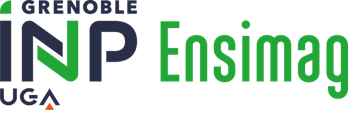Number of hours
- Lectures 11.25
- Projects -
- Tutorials 33.75
- Internship -
- Laboratory works -
- Written tests -
ECTS
ECTS 3.0
Goal(s)
To give the basic principle of digital transmission, consisting in sending digital information into physical (analog) channel. To give an overview of the digital communications techniques and equipments used in telecommunication radio-frequency. This courses use the Information Theory results (C. Shannon) to give and interpret achievable performance and position the performance of basic modulations techniques. It gives also a brief introduction of present radio transmission systems.
Laurent ROS, Steeve ZOZOR
Content(s)
1. Signal processing tools : random signal, narrow-band signal complex representation, correlation, power spectrum density, filtering,
2. Base-band digital transmission
- line code : M-ary modulation with orthogonal Dictionnaries, Linear Modulations (Pulse-amplitude Modulations), general properties (power, power spectrum density, euclidian distance, energy and spectral efficiencies)
- Performance over AWGN channel case: Matched filter (Correlator), Nyquist criteria (Free Inter-Symbol-Interference criterion)
3. Carrier frequency digital transmission :
-Digital modulation : I/Q modulation-demodulation, linear (phase, amplitude, quadrature-amplitude) modulations,
-Coherent reception (AWGN case): detection theory, performances (bit error rate, spectral efficiency, distance from information theory),
4. Radio transmission systems :
General information about transmission systems (microwave links, satellite links, and radio-mobile communications, introduction to advances transmissions techniques such as CDMA (used in UMTS, ...) and OFDM (used in DVB, TNT, ...).
The course will be illustrated by classical "exercices sessions" but also by "sessions on computing machines" that will result in the redaction of a report which will be noted (1/4 of the overall mark).
PrerequisitesBasic courses in signal processing, and in information and coding theory
1 Written exam (2 h) (E).
1 report after "sessions on computing machines" (C)
N1=E1x0.75 + Cx0.25
N2=E2x0.75 + Cx0.25
The course exists in the following branches:
- Curriculum - Embedded Systems & Connect. Devices - Semester 8
Course ID : 4MMSICN
Course language(s): 
The course is attached to the following structures:
You can find this course among all other courses.
Glavieux, M. Joindot. Communications numériques, introduction. Collection pédagogique des télécommunications, Masson, 1996.
J. Proakis. Digital Communications. McGraw-Hill, 2000.
Frédéric de Coulon, « Théorie et Traitement des Signaux », presses Polytechniques Romandes, 5°édition, 1998



